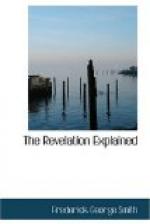We must now determine about what time the great persecutions referred to ceased, or nearly ceased, and that will give us the right starting-point from which to reckon the pouring out of the first vial. In A.D. 1685 the revocation of the Edict of Nantes, by Louis XIV. of France, took place, and in the terrible persecutions that occurred during his reign three hundred thousand are said to have lost their lives. The time that we are endeavoring to establish, then, must be later than the seventeenth century. Louis died in 1714. Persecutions continued from time to time in France, with considerable severity, until about the middle of the century. “Soon after this ... the flowing of heretic blood ceased, though an effort was made in 1765 by the Popish clergy to resist the tendency to toleration by a remonstrance to the king.” History of Romanism, p. 608. A few individual cases of persecution may have occurred later in other countries; but in the main we are safe in pointing to about the middle of the eighteenth century for the general cessation of these religious murders. We will now consider the nature of the first plague.
The pouring out of this vial produced the most painful malignant ulcers upon the human body. Such ulcers are evidently not political calamities; for the symbol is drawn, not from nature, but from human life. Still, it is not drawn from a human being as a whole (in which case religious events would be symbolized), but only from his body. What, then, is the analagous object of which the human body may stand as a proper representative? Evidently, the mind. We would naturally pass from the bodily to the mental; and what painful ulcers are to the one, marring its beauty and filling it with burning anguish, such are blasphemous opinions and malignant principles to the other.
Considering the time for this plague pointed out above, the student of Revelation who is acquainted with the history of the past will scarcely fail to discern at once, in the striking points of this symbol, those horrible principles of infidelity, atheism, and licentiousness, which were spread so extensively over Europe during the latter half of the eighteenth century, and which were the most efficient causes in bringing about the fearful convulsions which followed in the French Revolution. That all may understand this matter in its proper light, however, it will be necessary to state some of the facts respecting this “noisome and grievous sore” that fell at that time upon the inhabitants of Europe. In writing upon the causes that led up to the French Revolution, Mr. Wickes gathered the following facts of history mainly from the Encyclopaedia of Religious Knowledge, under the articles headed Philosophists and Illuminati. I will quote his own language, as it is very pointed.




